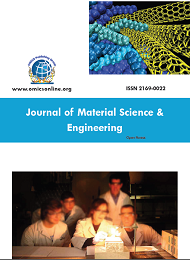Theme: Advancements and Frontiers in Bioworld Innovation: Biopolymers- Bio plastics
Biopolymers and Bioplastics 2016
ConferenceSeries Ltd invites you to attend the 3rd International Conference and Exhibition on Biopolymers and Bioplastics going to be held on September 12-14, 2016 at San Antonio, USA. The main theme of the conference is “Advancements and Frontiers in Bioworld Innovation: Biopolymers- Bio plastics”.
Biopolymers conferences and Bioplastics conferences 2016 International Conference is an attempt to explore the various ways to utilize natural resources for betterment of the future, promising a better tomorrow for the progeny and a better vision for the springing research. Biopolymers and Bioplastics 2016 is anticipated to be one the best scientific conferences in USA. The scientific sessions of this International Conference on Biopolymers events and Bioplastics events 2016 has been designed on vivacious topics such as Green Chemicals, Industrial Biotechnology, Micro and Nano blends based on natural polymers. Biopolymers conferences and Bioplastics conferences is consisting of well-organized scientific program and effervescent speeches by the expertise. ConferenceSeries Ltd Organizes 300+ Conferences, 500+ Workshops and 200+ Symposiums Every Year on Pharma, Medicine, Science and Technology across USA, Europe & Asia (conference series) with support from 1000 more scientific societies and Publishes 400+ Open access journals which contains over 30000 eminent personalities, reputed scientists as editorial board members. ConferenceSeries Ltd conferences always encourage the young researchers and students to share their excitement and enthusiasm with world class expertise.
By following the successful campaign of "Biopolymers conferences and Bioplastics 2015", ConferenceSeries Ltd Conferences is very delighted to Organize the “3rd International Conference and Exhibition on Biopolymers and Bioplastics” September 12-14, 2016 San Antonio, USA
On this propitious moment, we invite all the global participants to join us at San Antonio, USA for "Biopolymers and Bioplastics conferences 2016", where you will be sure to have a meaningful experience with world class professors, Researchers and many industrial experts from all around the world.
ConferenceSeries Ltd organizes a conference series of 3000+ Global Events with over 600+ Conferences, 1200+ Symposiums and 1200+ Workshops in USA, Europe & Asia with support from 1000 more scientific societies and publishes 700+ Open access journals which contains over 30000 eminent personalities, reputed scientists as editorial board members.
Track 1: Routes to drop-in monomers and bioplastics:
An emerging trend is the advancement of monomers from renewable carbon that are identical to those that currently produced from petroleum-derived raw material. Examples include diols (e.g. 1,3-propenediol, 1,4-butanediol), diacids (e.g. succinic and adipic acids), terephthalic acid and acrylic acid (C3H4O2). The attraction to this approach is that ‘drop in’ biobased products have well-established markets such that, if they can be produced at equivalent cost and quality, they will be adopted by producers. Drop in biobased monomers to authorize the yield of biobased drop-in polymers such as PBS (poly butylene succinate), PTT (poly trimethylene terephthalate), polyethylene (PE), polypropylene (PP), polyethylene terephthalate (PET) and biobased polyamides.
Biopolymers are polymers produced by living organisms; in other words, they are polymeric biomolecules. Since they are polymers, biopolymers contain monomeric units that are covalently bonded to form larger structures. There are three main classes of biopolymers, classified according to the monomeric units used and the structure of the biopolymer formed: polynucleotides (RNA and DNA), which are long polymers composed of 13 or more nucleotide monomers; polypeptides, which are short polymers of amino acids; and polysaccharides, which are often linear bonded polymeric carbohydrate structures.
Plastics belong to a group of molecules called polymers, which are large molecules made of repeating units called monomers. Most plastics contain between 500 and 20,000 or more repeating units. Plastics can be produced by bonding together monomers in a reaction called polymerization.
Monomers are the simple building blocks that when polymerization yield a macromolecule.
Biopolymers conferences | Bioplastics conferences | Biopolymers and Bioplastics conferences | Biopolymers-Bioplastics
2nd World Congress on Biopolymers August 1-3, 2016 Manchester, UK; International Conference on Sustainable Bioplastics November 10-12, 2016 Alicante, Spain; International Conference on Polymer Science and Engineering; 2nd International Congress on Biofuels and Bioenergy August 29-31, 2016 Sao Paulo, Brazil; International Conference on Chemical Engineering September 12-14, 2016 Phoenix, USA ; 3rd International Conference on Bio-based Polymers and Composites , 28 August-01September 2016 ,Szeged , Hungary; 14th International Symposium on Bioplastics, Biocomposites, and Biorefining Conference, 31 May to 3 June 2016, Guelph, Ontario; International Conference on Process Engineering and Advanced Materials September 01-03, Kuala Lumpur; Biomass for Sustainable Future: Re-Invention of Polymeric Materials February 9-11,2016, Las Vegas, USA; 18th International Conference on Bioplastics, Biocomposites and Biorefining, March 24 - 25, 2016, Madrid, Spain; 5th International Renewable Energy and Environment Conference (IREEC-2016), 11-13 July 2016, Madrid, Spain; British Plastics Federation; European Council for Plasticizers and Intermediates
Track 2: Future and Scope for Biopolymers and Bioplastics:
The use of biopolymers could markedly increase as more durable versions are developed, and the cost to manufacture these bio-plastics continues to go fall. Bio-plastics can replace conventional plastics in the field of their applications also and can be used in different sectors such as food packaging, plastic plates, cups, cutlery, plastic storage bags, storage containers or other plastic or composite materials items you are buying and therefore can help in making environment sustainable. Bio-based polymeric materials are closer to the reality of replacing conventional polymers than ever before. Nowadays, biobased polymers are commonly found in many applications from commodity to hi-tech applications due to advancement in biotechnology and public awareness.
In search of novel Advanced Materials solutions and keeping an eye on the goal of sustainable production and consumption, bioplastics have several (potential) benefits. The use of renewable resources to produce bioplastics the key for increasing resource productivity, the resources can be cultivated on an (at least) annual basis, the principle of cascade use, as biomass can primarily be used for materials and then for energy generation, a reduction of the carbon footprint and GHG egressions of some materials and products - saving fossil fuels resources, and for substituting them step by step.
- Biopolymers in Drug Delivery
- Global Bio-based Market growth of Biopolymers
- Biopolymers in Drug Delivery
- Biopolymers in Marine Sources
- Biopolymers from Renewable sources
- Biopolymers in Stem Cell Technology
- Ceramics and applications
Biopolymers conferences|Bioplastics conferences|Biopolymers and Bioplastics conferences|Biopolymers-Bioplastics
4th World Congress on Petrochemistry and Chemical Engineering December 5-7, 2016 Phoenix, USA; 5th World Congress on Materials Science and Engineering June 13-15, 2016 Alicante, Spain; International Conference on Polymer Chemistry November 14-16, 2016 Atlanta, USA; 2nd World Congress on Biopolymers August 1-3, 2016 Manchester, UK; International Conference on Sustainable Bioplastics November 10-12, 2016 Alicante, Spain; 3th Annual conference on Zing Hydrogen and Fuel Cells, October 10-12, 2016 Mexico; International Conference on Polymers December 5-6, 2016 Photovoltaic, Germany; International Bioplastics, Biocomposites and Biorefining Conference, December 14-15, 2016, Sydney, Australia; 3rd International Conference on Bio-based Polymers and Composites, 28 August-01September 2016, Szeged, Hungary; 29th International Symposium on Polymer Analysis and Characterization Singapore, June 12-15, 2016; 8th European Bioplastics Conference 19-26 October, 2016, Germany; American Coatings Association; American Chemical Society (Division of Polymer Chemistry)
Track 3: Industrial Biotechnology and Biorefineries:
Industrial Biorefineries and White Biotechnology brings a comprehensive look at the increasing focus on developing the processes and technologies needs for the conversion of biomass to liquid and gaseous fuels and chemicals, in specific, the development of low-cost Technologies Adoption. During the last 3-4 years, there have been scientific and technological developments in the field; this book represents the most updated information and technological perspective on the theme. Industrial biotechnology uses enzymes and micro-organisms to make biobased products in sectors such as chemicals, detergents, food and feed, paper and pulp, textiles and bioenergy (such as biofuels or biogas). In doing so, it utilizes renewable raw materials and is one of the most promising, innovative approaches towards lowering greenhouse gas emissions. The application of industrial biotechnology has been proven to make significant contributions towards moderating the impacts of climate change in these and other sectors. In addition to environmental benefits, biotechnology can enhance industry’s performance and product value and, as the technology develops and matures, white biotechnology will yield more and more feasible solutions for our environment. These innovative solutions bring added benefits for both our climate and our economy.
Biopolymers conferences|Bioplastics conferences|Biopolymers and Bioplastics conferences|Biopolymers-Bioplastics
4th International Conference on Bioprocess and Biosystems Engineering October 20-21, 2016 Houston , USA; 4th World Congress on Petrochemistry and Chemical Engineering December 5-6, 2016 Phoenix, USA; World Biodiesel Congress & Expo December 05-07, 2016 San Antonio, USA; 2nd International Congress on Biofuels and Bioenergy September 01-03, 2016 Sao Paulo, Brazil; 4th International Conference on Petroleum Engineering August 15-17, 2016 London, UK; International Conference on Oil Spill and Ecosystem Science, August 18-20, 2016 Tampa, Florida; International Conference on Inorganic Polymers Conference, July 21-13, 2016 San Diego, USA; 5thInternational Conference on Bio-based Materials, June 16-18, 2016 Cologne, Germany; 18th Bioeconomy and Sustainable Development, August 15-16 Istanbul, Turkey; 24th processing and application of polymers Symposium November 12 - 13 2016 Chemnitz; American Physical Society Division of Polymer Physics (APS DPOLY); Polymer Division of the Royal Australian Chemical Institute (RACI Polymer Division)
Track 4: Plastic Pollution and Waste Management:
Plastic pollution involves the aggregation of plastic products in the environment that adversely affects wildlife, wildlife habitat, or human kinds. Plastics that act as pollutants are categorized into micro, meso, or macro debris, based on size. The importance of plastic pollution is correlated with plastics being inexpensive and durable, which lends to high levels of plastics used by human beings. However, it is slow to degrade. Humans are also affected by plastic pollution, such as through the interruption of the thyroid hormone axis or sex hormone levels. Plastic efforts have occurred in some regions in attempts to reduce plastic consumption and pollution and promote plastic recycling.
The use of biodegradable plastics has been shown to have many advantages and disadvantages. Biodegradables are biopolymers that degrade in industrial composters. Biodegradables do not degrade as efficiently in domestic composters, and during this slower process, methane gas may be emitted.
There are also other types of degradable materials that are not considered to be biopolymers, because they are oil-based, similar to other conventional plastics. These plastics are made to be more degradable through the use of different additives, which help them degrade when exposed to UV rays or other physical stressors. However, biodegradation promoting additives for polymers have been shown not to significantly increase biodegradation.
Although biodegradable plastics and degradable plastics have helped reduce plastic pollution, there are some drawbacks. One issue concerning both types of plastics is that they do not break down very efficiently in natural environments. There, degradable plastics that are oil-based may break down into smaller fractions, at which point they do not degrade further.
Biopolymers conferences|Bioplastics conferences|Biopolymers and Bioplastics conferences|Biopolymers-Bioplastics
International Conference on Sustainable Bioplastics November 10-12, 2016 Alicante, Spain; Euro Global Summit on Biomass August 08-10, 2016 Birmingham, UK ; 2nd World Congress on Biopolymers August 1-3, 2016 Manchester, UK ; International Conference on Chemical Engineering September 12-14, 2016 Phoenix, USA; International Conference on Polymer Science and Engineering August 22-24, 2016 New Orleans, USA; Annual conference on Waste Management and the Environment, October 10-12, 2016 Valencia, Spain; 5th International Renewable Energy and Environment Conference (IREEC-2016) ,11-13 July 2016, Madrid, Spain; International Conference on Waste Management, Recycling and Environment, September 01-03, 2016 Barcelona, Spain; Annual conference on Global waste management symposium, November 10-12, 2016 Palm Springs, USA; 18th Bioeconomy and Sustainable Development, August 15-16 Istanbul, Turkey; Belgian Polymer Group (BPG); Brazilian Polymer Association
Track 5: Biocomposite Materials:
Biocomposites is a composition material formed by a matrix and a reinforcement of natural fibers. Green composite are differentiated as a bio composite combined by natural fibers with biodegradable resins. They are called green composites, majorly because of their degradable and sustainable properties, which can be easily disposed without harming the environment. Because of its durability, green composites are majorly utilized to increase the life cycle of products with short life. A different class of Biocomposites, called hybrid bio composite which is based on different types of fibers into a single matrix. The fibers can be synthetic or natural, and can be randomly combined to generate the hybridization. The worldwide capacity for production of "C" (carbon) fibres was 111, 785 tons in 2012. In 2016 it is set to reach 156,845 tonnes and in 2020, it was set to reach 169,300tonnes. In relation to these nominal capacities, actual production only represents a part, estimated at 60% in 2012, 68% in 2016 and 72% in 2020. Demand was 47,220 t in 2012. It is set to reach 74,740tonnes in 2016 and 102,460tonnes in 2020. This over-capacity could lead to maintaining competitive prices. Hydrocarbons fiber matrix composite materials are made 72 % from epoxy.
Biopolymers conferences|Bioplastics conferences|Biopolymers and Bioplastics conferences|Biopolymers-Bioplastics
2nd International Conference on Ceramics and Composite Materials July 25-27, 2016 Berlin, Germany ; 5th World Congress on Materials Science and Engineering June 13-15, 2016 Alicante, Spain; 6th International Conference on Materials Science and Engineering September 01-03, 2016 Atlanta, USA; 2nd World Congress on Biopolymers August 1-3, 2016 Manchester, UK ; International Conference on Polymer Science and Engineering June 23-24, 2016 New Orleans, USA; Annual conference on Mechanics of Composites, July 21-23, 2016 Portugal; Annual conference on Advanced Ceramics and Composites, June 16-18, 2016 Florida, USA; International Conference on Composites June 16-18, 2016 Stuttgart, Germany; 9th International Conference on Bio-based Materials, 05-06 April 2016, Maternushaus, Cologne, Germany; 14th International Symposium on Bioplastics, Biocomposites, and Biorefining Conference, 31 May to 3 June 2016, Guelph, Ontario; International Bioplastics, Biocomposites and Biorefining Conference, December 14-15, 2016,Sydney Australia; European Polymer Federation; Bioenvironmental Polymer Society
Track 6: Biomaterials and Biopolymers:
Polymer Nano composites (PNC) comprise of a polymer or copolymer having nanoparticles or Nano fillers dispersed in the polymer matrix. Plastic packaging for food & non-food applications is non-biodegradable, and also uses up valuable and insufficient non-renewable resources like petroleum. With the current focus on exploring alternatives to petroleum and prominence on reduced environmental impact, research is increasingly being directed at development of biodegradable food packaging from biopolymer-based materials. A biomaterial is any matter, surface, or construct that interacts with biological systems. As a science, biomaterials are around fifty years old. The study of biomaterials is called biomaterials science. It has experienced stable and strong growth over its history, with many companies investing large amounts of money into the development of novel products. Biomaterials science encompasses elements of medicine, biology, chemistry, tissue engineering and materials science. World biomaterial market over the forecast period of 2012-2017. The global market place for biomaterials is estimated at $44.0 billion in 2012 and is poised to grow at a CAGR of 15% from 2012 to 2017 to reach $88.4 billion by 2017
Biopolymers conferences|Bioplastics conferences|Biopolymers and Bioplastics conferences|Biopolymers-Bioplastics
2nd International Conference on Ceramics and Composite Materials July 25-27, 2016 Berlin, Germany ; 5th World Congress on Materials Science and Engineering June 13-15, 2016 Alicante, Spain; 6th International Conference on Materials Science and Engineering September 01-03, 2016 Atlanta, USA; 2nd World Congress on Biopolymers August 1-3, 2016 Manchester, UK ; International Conference on Polymer Science and Engineering June 23-24, 2016 New Orleans, USA; Annual conference on Mechanics of Composites, July 21-23, 2016 Portugal; Annual conference on Advanced Ceramics and Composites, June 16-18, 2016 Florida, USA; International Conference on Composites June 16-18, 2016 Stuttgart, Germany; 9th International Conference on Bio-based Materials, 5 - 6 April 2016, Maternushaus, Cologne, Germany; 14th International Symposium on Bioplastics, Biocomposites, and Biorefining Conference, 31 May to 3 June 2016, Guelph, Ontario; International Bioplastics, Biocomposites and Biorefining Conference, December 14-15, 2016,Sydney Australia; American Chemical Society (Division of Polymer Chemistry); Brazilian Polymer Association
Track 7: Production and Commercialization:
Even though they still account for only a minute share of the plastics market as a whole, bioplastics have become a true alternative to standard plastics manufactured from petrochemical feedstock’s. The term 'bioplastics' is utilized for a wide range of various products with different properties and applications. In its recently published study, Markets and Markets is a market research company and consulting firm based in the U.S. We publish strategically analyzed market reports and serve as a business intelligence partner to Fortune 500 companies across the world. Markets and Markets also provide multi-client reports, company profiles and custom research services. Markets and Markets covers thirteen industry verticals, includes advanced materials, automotive and transportation, banking and financial services, biotechnology, chemicals, energy and power, food and beverages, medical devices, pharmaceuticals, semiconductor and electronics, telecommunications and IT. We at Markets and Markets are inspired to help our clients grow by providing apt business insight with our vast market intelligence repository. The global market for implantable Biopolymers and Bioplastics was worth around $155.7 billion in 2014. This market is expected to grow at a compound annual growth rate of 7.2% between 2014 and 2019 results in $155.7 billion in 2014 and $200.5 billion global market in 2019.
Biopolymers conferences|Bioplastics conferences|Biopolymers and Bioplastics conferences|Biopolymers-Bioplastics
4th World Congress on Petrochemistry and Chemical Engineering December 5-7, 2016 Phoenix, USA; 5th World Congress on Materials Science and Engineering June 13-15, 2016 Alicante, Spain; International Conference on Polymer Chemistry November 14-16, 2016 Atlanta, USA; 2nd World Congress on Biopolymers August 1-3, 2016 Manchester, UK; International Conference on Sustainable Bioplastics November 10-12, 2016 Alicante, Spain; 3th Annual conference on Zing Hydrogen and Fuel Cells, October 10-12, 2016 Mexico; International Conference on Polymers December 5-6, 2016 Photovoltaic, Germany; International Bioplastics, Biocomposites and Biorefining Conference, December 14-15, 2016, Sydney Australia; 3rd International Conference on Bio-based Polymers and Composites, 28 August-01 September 2016 ,Szeged, Hungary; 29th International Symposium on Polymer Analysis and Characterization Singapore, June 12-15, 2016; 8th European Bioplastics Conference 19-26 October 2016, Germany; American Physical Society Division of Polymer Physics (APS DPOLY); Belgian Polymer Group (BPG)
Biopolymers conferences|Bioplastics conferences|Biopolymers and Bioplastics conferences|Biopolymers-Bioplastics
Bio-based polyesters are of high interest by academic and industrial scientists and engineers. One member of this family is poly (lactic acid), PLA, is renewable, biocompatible and also biodegradable and is one of the most widely used biopolyesters. PLA is obtained either by ring opening polymerization (ROP) of lactide or by direct polycondensation of lactic acid. Another biopolyester with a wide range of interesting properties are Polyhydroxyalkanoates (PHA). These families of biopolyesters are produced directly by microorganisms from various carbon sources. Efforts are underway to develop more efficient production organisms, use this biological pathway for the production of other biopolyesters such as PLA, develop more efficient downstream processing methods, produce PHAs from waste materials and much more. These are just two examples of a wide family of polymers that have tremendous potential to make important contributions to the introduction of biobased plastics.
Biopolymers conferences|Bioplastics conferences|Biopolymers and Bioplastics conferences|Biopolymers-Bioplastics
2nd World Congress on Biopolymers August 1-3, 2016 Manchester, UK; International Conference on Sustainable Bioplastics November 10-12, 2016 Alicante, Spain; International Conference on Polymer Science and Engineering; 2nd International Congress on Biofuels and Bioenergy August 29-31, 2016 Sao Paulo, Brazil; International Conference on Chemical Engineering September 12-14, 2016 Phoenix, USA; 3rd International Conference on Bio-based Polymers and Composites, 28 August-01September 2016, Szeged, Hungary; 14th International Symposium on Bioplastics, Biocomposites, and Biorefining Conference, 31 May to 3 June 2016, Guelph, Ontario; International Conference on Process Engineering and Advanced Materials September 01-03, Kuala Lumpur; Biomass for Sustainable Future: Re-Invention of Polymeric Materials February 9-11,2016, Las Vegas, USA; 18th International Conference on Bioplastics, Biocomposites and Biorefining, March 24 - 25, 2016, Madrid, Spain; 5th International Renewable Energy and Environment Conference (IREEC-2016) ,11-13 July 2016, Madrid, Spain; Polymer Division of the Royal Australian Chemical Institute (RACI Polymer Division) ; European Council for Plasticizers and Intermediates
Track 9: Biobased Thermosetting Polymers:
Thermosetting plastics are polymer materials which are liquid or malleable at low temperatures, but which change irreversibly to become hard at high temperatures. A major effort is underway to recognize biobased epoxy resins that can substitute for existing petroleum-based materials such as bis-phenol A diglycidyl ether[C21H24O4] (BADGE). Unfortunately, bis-phenol A (BPA) is particularly problematic as it is differentiated as a reprotoxic R2 substance and an endocrine disruptor. The production of overall epoxy thermosetting polymers is estimated to be 2 million tons in 2010 and is projected to reach 3 million tons by 2017. Their global market was estimated at about US$18 billion in 2012 and is forecasted to reach US$21.5 billion by 2015. More than 60% of the overall production is used in the coatings industry. Furthermore, epoxies are apparently the most versatile family of adhesives because they are compatible with many substrates, and can be easily modified to attain widely varying properties. Control of properties and also processing is usually based on the selection of the relevant epoxy precursors or combination of monomers, on the selection of curing agents and associated reaction mechanism, and on the inclusion of organic or inorganic fillers and components. Work is underway to develop BPA replacements from various biobased feedstocks’ as well lignin derived chemicals.
Biopolymers conferences|Bioplastics conferences|Biopolymers and Bioplastics conferences|Biopolymers-Bioplastics
2nd World Congress on Biopolymers August 1-3, 2016 Manchester, UK; International Conference on Sustainable Bioplastics November 10-12, 2016 Alicante, Spain; International Conference on Polymer Science and Engineering; 2nd International Congress on Biofuels and Bioenergy August 29-31, 2016 Sao Paulo, Brazil; International Conference on Chemical Engineering September 12-14, 2016 Phoenix, USA ; 3rd International Conference on Bio-based Polymers and Composites , 28 August-01September 2016 ,Szeged , Hungary; 14th International Symposium on Bioplastics, Biocomposites, and Biorefining Conference, 31 May to 3 June 2016, Guelph, Ontario; International Conference on Process Engineering and Advanced Materials September 01-03, Kuala Lumpur; Biomass for Sustainable Future: Re-Invention of Polymeric Materials February 9-11,2016, Las Vegas, USA; 18th International Conference on Bioplastics, Biocomposites and Biorefining, March 24 - 25, 2016, Madrid, Spain; 5th International Renewable Energy and Environment Conference (IREEC-2016) ,11-13 July 2016, Madrid, Spain; Bioenvironmental Polymer Society; British Plastics Federation
Track 10: Biodegradable Polymers:
Biopolymers are polymers that are biodegradable. The input materials for the production of these polymers may be either renewable (based on agricultural plant or animal products) or synthetic. Current and future developments in biodegradable polymers and renewable input materials focus relate mainly to the scaling-up of production and improvement of product properties. Larger scale production will increase availability and reduce prices. Currently either renewable or synthetic starting materials may be used to produce biodegradable polymers. Two main strategies may be followed in synthesizing a polymer. One is to build up the polymer structure from a monomer by a process of chemical polymerization. The alternative is to take a naturally occurring polymer and chemically modify it to give it the desired properties. A disadvantage of chemical modification is however that the biodegradability of the polymer may be adversely affected. Therefore it is often necessary to seek a compromise between the desired material properties and biodegradability.
Increased use of biopolymers would reduce the dependence on fossil fuels; another advantage is that biopolymers are easily bio-degradable.
Biopolymers conferences|Bioplastics conferences|Biopolymers and Bioplastics conferences|Biopolymers-Bioplastics
International Conference on Sustainable Bioplastics November 10-12, 2016 Alicante, Spain; Euro Global Summit on Biomass August 08-10, 2016 Birmingham, UK ; 2nd World Congress on Biopolymers August 1-3, 2016 Manchester, UK ; International Conference on Chemical Engineering September 12-14, 2016 Phoenix, USA; International Conference on Polymer Science and Engineering August 22-24, 2016 New Orleans, USA; Annual conference on Waste Management and the Environment, October 10-12, 2016 Valencia, Spain; 5th International Renewable Energy and Environment Conference (IREEC-2016) ,11-13 July 2016, Madrid, Spain; International Conference on Waste Management, Recycling and Environment, September 01-03, 2016 Barcelona, Spain; Annual conference on Global waste management symposium, November 10-12, 2016 Palm Springs, USA; 18th Bioeconomy and Sustainable Development, August 15-16 Istanbul, Turkey; European Council for Plasticizers and Intermediates; European Polymer Federation
Track 11: Biopolymer Applications :
Polymers have properties that make them suitable for use in protecting products from moisture, increasing shelf-life and making products easier to dispense. Every biopolymer has its own material-specific properties, e.g. barrier properties such as oxygen permeability. The barrier properties are relevant to the choice of biopolymers for the packaging of particular products. Bioplastics have very promising prospects for use in pesticide soil pins, for packaging in-flight catering products and for packaging dairy products.
Sugar based biopolymers Applications: Polyalctides decompose harmlessly in the human body and have therefore long been used for medical applications. Examples include surgical implants which do not require operative removal. Until recently, it was not feasible to use polylactides for packaging because of their high price, around US$500 per kilogram.
Cellulose based Biopolymers Applications: Familiar applications of cellophane include packaging for CDS, confectionary and cigarettes. The material is gradually falling out of favour, however, owing to its high price (about US$6 per kilogram). Other cellulose polymer materials (e.g. cellulose ilm) have also been commercially available for many years but are losing market share to newer polymers such as polypropylene.
Synthetic based Biopolymers Applications: The relatively high price of biodegradable polymers of synthetic substances, e.g. aliphatic aromatic copolyesters has prevented them from reaching a large scale market. The best known application is for making substrate mats.
The major advantage of biodegradable packaging is that it can be composted. But the biodegradability of raw materials does not necessarily mean that the product or package made from them (e.g. coated paper) is itself compostable. Biopolymers can also have advantages for waste processing. Coated paper (with e.g. polyethylene) is a major problem product for composting. Although such materials are usually banned from inclusion in organic waste under separate collection schemes, some of them usually end up nonetheless in the mix. The paper decomposes but small scraps of plastic are left over in the compost. The adoption of biopolymers for this purpose would solve the problem.
Biopolymers conferences|Bioplastics conferences|Biopolymers and Bioplastics conferences|Biopolymers-Bioplastics
International Conference on Polymer Chemistry November 14-16, 2016 Atlanta, USA; 5th World Congress on Materials Science and Engineering June 13-15, 2016 Alicante, Spain; 2nd World Congress on Biopolymers August 1-3, 2016 Manchester, UK ; International Conference on Polymer Science and Engineering August 22-24, 2016 New Orleans, USA; International Conference on Sustainable Bioplastics November 10-12, 2016 Alicante, Spain; 3th Annual conference on Zing Hydrogen and Fuel Cells, October 10-12, 2016 Mexico; International Conference on Polymers December 5-6, 2016 Photovoltaic, Germany; International Bioplastics, Biocomposites and Biorefining Conference, December 14-15, 2016, Sydney, Australia; 3rd International Conference on Bio-based Polymers and Composites , 28 August-01 September 2016, Szeged, Hungary; 29th International Symposium on Polymer Analysis and Characterization Singapore, June 12-15, 2016; 8th European Bioplastics Conference 19-26 October 2016, Germany; American Coatings Association; American Physical Society Division of Polymer Physics (APS DPOLY)
3rd International Conference and Exhibition on Biopolymers and Bioplastics
September 12-14, 2016 at San Antonio, USA
Summary:
Bioplastics are a form of plastics made entirely or almost entirely from renewable raw materials such as vegetable oil, corn starch, biomass whereas conventional plastics are made from petroleum (oil or gas). Bio-plastics can replace conventional plastics in the field of their applications also and can be used in different sectors such as food packaging, plastic plates, cups, cutlery, plastic storage bags, storage containers or other plastic or composite material items you are buying.
Biopolymers conferences and Bioplastics conferences-2015 is an event delivering the concept of biobased world across the globe. In the present world where the use of conventional plastics, the consequences of plastic products use and the waste management of these products when they become waste, is a current and pressing issue. Concerns focus on the potential impact of conventional plastics they cause to the environment.
For more details please visit: http://biopolymers-bioplastics.conferenceseries.com/
Importance & Scope:
The history of Bioplastics is not a elongated one. They are beginning to emerge as a result of needing to be more responsible in taking care of the world we are living in. Thus, the recent emergence of bio-based products rather than petroleum or natural gas based products. Several reasons are associated with the research and development of Biopolymers and Bioplastics. The usage of bio-plastics could markedly increase as more durable versions are developed, and the cost to manufacture these bio-plastics continues to go spill. Bio-plastics can replace conventional plastics in the field of their applications also and can be utilized in different sectors such as food packaging, plastic cups, plates, cutlery, plastic storage bags, storage containers or the other plastic or composite material items you are buying and therefore can help in making environment sustainable.
Biopolymers can be sustainable, carbon neutral and are always renewable, because they are made from plant materials which can be grown indefinitely. These plant materials come from agricultural non food crops. Therefore, the use of biopolymers would create a sustainable industry. In contrast, the feedstocks for polymers derived from petrochemicals will eventually deplete. In addition, biopolymers have the potential to cut carbon emissions and reduce CO2 quantities in the atmosphere: this is because the CO2 released when they degrade can be reabsorbed by crops grown to replace them: this makes them close to carbon neutral.Biopolymers are biodegradable, and some are also compostable. Some biopolymers are biodegradable: they are broken down into CO2 and water by microorganisms. Some of these biodegradable biopolymers are compostable: they can be put into an industrial composting process and will break down by 90% within six months. Biopolymers that do this can be marked with a 'compostable' symbol, under European Standard EN 13432 (2000).Many types of packaging can be made from biopolymers: food trays, blown starch pellets for shipping fragile goods, thin films for wrapping.
Why San Antonio?
San Antonio is the 7th largest city in the United States of America and the 2nd largest city within the state of Texas, with a population of 1.33 million. The city was named after San Antonio de Padua, whose feast day is on June 13, when a Spanish expedition stopped in the area in 1691.
Famous for Spanish missions, the Alamo, the River Walk, the Tower of the Americas, the Alamo Bowl, Marriage Island and host to SeaWorld and Six Flags Fiesta Texas theme parks, the city is visited by approximately 26 million tourists per year according to the San Antonio Convention and Visitors Bureau.
The city is home to the four-time NBA champion San Antonio Spurs and the annual San Antonio Stock Show & Rodeo, one of the largest in the country. San Antonio has a strong military presence. It is home to Fort Sam Houston, Lack Land Air Force Base, Randolph Air Force Base, and Brooks City-Base, with Camp Bullis and Camp Stanley outside the city. Kelly Air Force Base was operated out of San Antonio until 2001, when the airfield was transferred over to Lakeland AFB and the remaining portions of the base became Port San Antonio, an industrial/business park. San Antonio is home to five Fortune 500 companies and the South Texas Medical Center, the only medical research and care provider in the South Texas region.
Why to attend???
Biopolymers and Bioplastics-2016 is an event delivering the concept of biobased world across the globe. In the present world where the use of conventional plastics, the consequences of plastic products use and the waste management of these products when they become waste, is a current and pressing issue. Concerns focus on the potential impact of conventional plastics they cause to the environment.
Conference Highlights:
- Routes to drop-in monomers and bioplastics
- Future and Scope for Biopolymers and Bioplastics
- Industrial Biotechnology and Biorefineries
- Plastic Pollution and Waste Management
- Biocomposite materials
- Biomaterials and Biopolymers
- Production and Commercialization
- New-to-the-world Biopolyesters
- Biobased Thermosetting Polymers
- Biodegradable Polymers
- Biopolymer Applications
- Biopolymer Companies and Market
Major Associations around the Globe:
- British Plastics Federation
- European Council for Plasticizers and Intermediates
- American Coatings Association
- American Chemical Society (Division of Polymer Chemistry)
- American Physical Society Division of Polymer Physics (APS DPOLY)
- Polymer Division of the Royal Australian Chemical Institute (RACI Polymer Division)
- Belgian Polymer Group (BPG)
- Brazilian Polymer Association
- European Polymer Federation
- Bioenvironmental Polymer Society
Target Audience:
- Eminent Scientists of biopolymers and bioplastics
- Chemical engineering Research Professors
- Junior/Senior research fellows of biomaterials and bioproducts
- CEO’s of biopolymers companies
- Members of different physics associations of Biopolymers and bioplastics
- Biopolymers doctorates
Top Universities in USA:
- University of Massachusetts Amherst
- Tufts University
- Northeastern University
- Stanford University
- Massachusetts Institute of Technology (MIT)
- Boston University
For more details please visit here.
Conference Highlights
- Routes to drop-in monomers and bioplastics
- Future and Scope for Biopolymers and Bioplastics
- Industrial Biotechnology and Biorefineries
- Plastic Pollution and Waste Management
- Biocomposite materials
- Biomaterials and Biopolymers
- Production and Commercialization
- New-to-the-world Biopolyesters
- Biopolymer Companies and Market
- Biobased Thermosetting Polymers
- Biodegradable Polymers
- Biopolymer Applications
- Condensation Polymers
- Nanopolymers
- Thermo Plastics
To share your views and research, please click here to register for the Conference.
To Collaborate Scientific Professionals around the World
| Conference Date | September 12-13, 2016 | ||
| Sponsors & Exhibitors |
|
||
| Speaker Opportunity Closed | Day 1 | Day 2 | Day 3 |
| Poster Opportunity Closed | Click Here to View | ||
Useful Links
Special Issues
All accepted abstracts will be published in respective Our International Journals.
- Journal of Bioremediation & Biodegradation
- Journal of Material Sciences & Engineering
- Advanced Chemical Engineering
Abstracts will be provided with Digital Object Identifier by




































